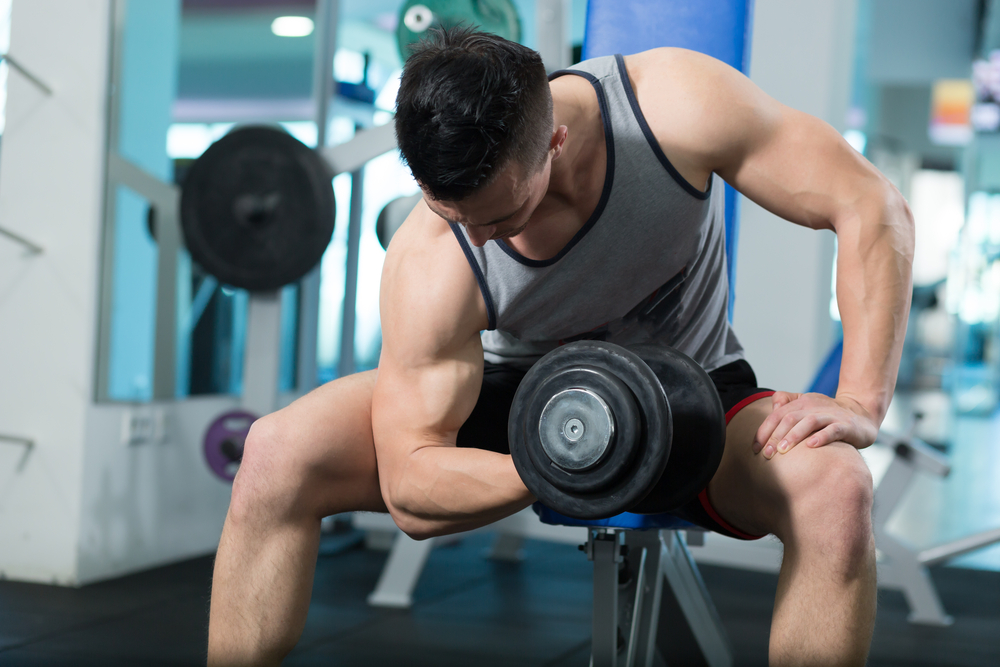Regular dumbbell curls make up the foundation of arm workouts all over the world.
Concentration curls also play a key role in arm-building programs and are popular with those wanting to build their bicep peak.
In this article, we compare the difficulty level of concentration curls and dumbbell curls to see which one is harder.
Let’s get started.

Are Concentration Curls Harder Than Dumbbell Curls?
On the surface, this is quite tough to answer as it depends on how you measure the difficulty of an exercise.
In terms of how much weight you can lift, concentration curls are considered harder as you can typically lift less weight.
This is because your biceps are isolated during the movement so no other muscles can assist.
If you look at difficulty in terms of the number of muscles being used, dumbbell curls are the harder of the two as they require more muscles which increases the overall workload.
Why Some People Find Concentration Curls Harder
Momentum Is Removed
During concentration curls, your leg supports your working arm.
This prevents your arm from moving out of position and generating momentum through swinging or using other muscle groups.
If you’re used to free moving exercises, like dumbbell curls, this can make concentration curls seem challenging.
Your Biceps Are Isolated
Usually, other muscle groups such as your forearms and shoulders help your biceps.
But during concentration curls, your biceps have to do pretty much all of the work as they’re isolated during the exercise.
Isolating your biceps makes lifting more challenging than if other muscle groups were helping out.
Why Some People Find Dumbbell Curls Harder
You Can Lift More Weight
As your biceps aren’t isolated during dumbbell curls, you’re able to lift more weight than you can in concentration curls.
This can make dumbbell curls seem harder if you’re used to lifting lighter weights.
Lifting heavier weights puts more stress on the working muscles, which can make the exercise seem difficult.
More Muscle Groups Are Working
Another reason why some find dumbbell curls harder is that more muscles are working at the same time.
The more muscles that engage simultaneously, the more energy and effort you need.
During dumbbell curls, your biceps are working hard (obviously) but your forearms, core, and shoulders also help in the movement as stabilizing muscles.
Whereas only your biceps activate during concentration curls.
Are Concentration Curls Suitable For Beginners?
Concentration curls are relatively simple to perform when you consider the technique and movement involved.
So, you could argue that they’re beginner friendly.
That said, beginners are usually better off focusing on compound exercises, as these give you more bang for your buck.
But if you really want to do concentration curls as a beginner, there’s no reason why you can’t.
How To Make Concentration Curls Harder
Like with pretty much any exercise, there are multiple variables you can manipulate to make the exercise more challenging.
Here’s a few simple ways you can make concentration curls harder.
Increase The Weight
Let’s start off with an obvious one.
Increasing the weight used is the most common way to make any exercise more challenging.
That isn’t to say it’s the most effective.
If your form suffers as a result of increasing the weight, you may see less progress and increase your risk of injury.
Increase The Time Under Tension
Many people believe that the eccentric (i.e. lowering phase) of an exercise is the most challenging.
When doing concentration curls, you can add difficulty by simply increasing the time taken to lower the weight.
Over a number of reps, you’ll definitely notice an increase in difficulty.
Swap A Dumbbell For A Cable
Dumbbells are typically used for concentration curls.
By swapping dumbbells for a cable, your bicep will be under a large amount of tension throughout the whole movement.
(When using dumbbells, your biceps are under a lot less tension at the top part of the movement.)
Sources
Concentration Curls Muscles Worked
I’ve been in the fitness and strength training industry for nearly a decade. In that time, I’ve gained 30 pounds of muscle, written hundreds of articles, and reviewed dozens of fitness supplements. As for my educational background, I’m a currently studying for my Active IQ Level 3 Diploma in Personal Training.

